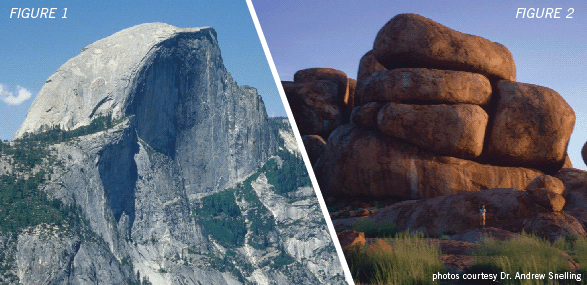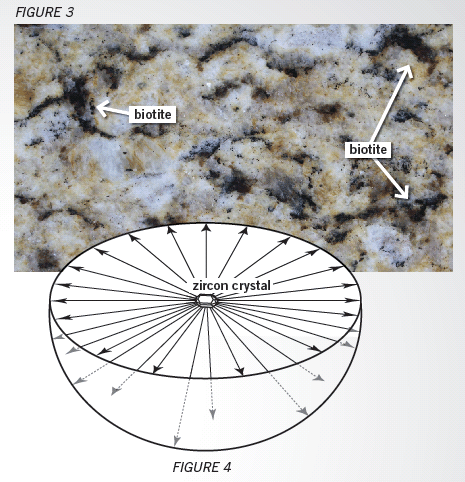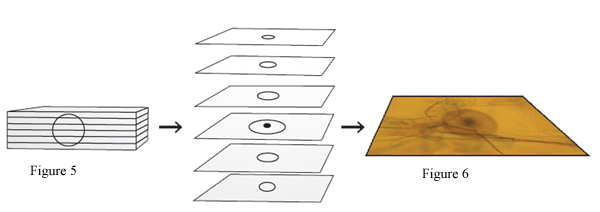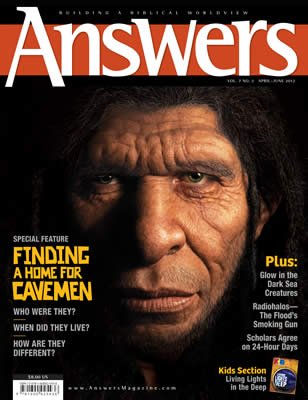
Radiohalos—Mysterious Bullet Holes in Rocks
Part One
The tiny black flecks found in granite testify to a powerful and recent worldwide Flood. But you have to look closely.
Radiohalos—The Flood’s Smoking Gun
Most people are familiar with granite. Several famous cliffs are made of granite, such as the sheer towering cliffs on either side of the Yosemite Valley—El Capitan and Half Dome (Figure 1). In other places granites cover the ground with large rounded boulders, such as the Devil’s Marbles in central Australia (Figure 2).
We also see granites used for countertops in many home kitchens. Their colorful, interlocking crystals give the rock an elegant, sought-after flecked appearance (Figure 3). Along with glassy, pink, and cream crystals, granites usually contain scattered flakes of a dark, shiny mineral called biotite.

WORLDWIDE TESTIMONY TO THE FLOOD—LOCKED IN GRANITE. Granite is one of the most common rocks on the planet, seen in places like Half Dome in Yosemite (Figure 1) and the Devil’s Marbles in central Australia (Figure 2). Inside the granite is radioactive damage, called radiohalos, which is best explained by granite forming quickly during a recent, worldwide catastrophe.
These are more than just pretty rocks. They have amazing stories to tell. Just one of those stories has to do with the flakes of biotite. Sometime during the Flood, these flakes were damaged at the atomic level. If we can piece together their story, these flakes can tell us more about the forces that God used to judge the earth during the Flood—and to form new granites from molten conditions in only hours or days, not millions of years.
But to investigate that story requires a bit of background on that tiny black mineral found in granite. The first article in this three-part series explains a few things we can learn about a rock’s history by looking at it under a microscope. God placed phenomenal clues in nature about the Flood’s history, if we only know where to look. Understanding these evidences helps us to glorify “the God of the hills” (1 Kings 20:28).

WHAT ARE RADIOHALOS? (Figures 3 and 4) Granite is filled with tiny black specks, which give the granite its beauty in countertops. These black specks are the mineral called biotite.
Creationists are interested in something mysterious within this black mineral. Under a microscope, they find something that looks like “bullet holes”—round places where the mineral has been damaged. What caused this damage?
Within the biotite are small radioactive crystals, called zircons. When the radioactive elements in zircons decay, they shoot out particles in all directions. These “bullets,” known as alpha particles, cause damage to the surrounding material. This damaged area looks like a sphere around the zircon, called a “radioactive halo,” or simply radiohalo.
Biotite Flakes and Zircon Crystals
To the unaided eye, the flat surfaces of the biotite flakes in granites look polished and smooth. However, under a microscope, the brown or green biotite flakes often contain impurities, tiny crystals of other types of minerals. It is as if biotite crystals grew around previous minerals, like a tree might grow around a nail. One of these minerals, which is of special interest to us, is zirconium silicate (ZrSiO4). Crystals of zirconium silicate are called zircons, named after the distinctive atom of the mineral.
Biotite flakes consist of layers and layers of ultra-thin crystal sheets, stacked on top of one another like the pages of a book. Wedged between these sheets are tiny zircons (like bookmarks between pages of a book).
An additional characteristic of zircons is that they are radioactive. None of the atoms of pure zirconium silicate are radioactive. However, uranium atoms (which are radioactive) are so similar in size and electric charge to zirconium atoms that they can “play the part” of zirconium atoms. When zircon crystals form, any uranium atoms in the vicinity can replace zirconium atoms in the zircon’s crystal structure.
Once the zircons form, the trapped uranium atoms start breaking apart or releasing pieces because the uranium nucleus is very large and highly unstable. The nuclear binding forces can’t hold together all 238 of the particles in the nucleus. When they release pieces, this is called radioactive decay. Two protons (particles with a positive electric charge) and two neutrons (particles with no electric charge) are ejected from the nucleus of each uranium atom.
Alpha Particles
The two protons and two neutrons are “clumped” together when ejected, behaving as a single unit. This unit, called an alpha particle, is itself the very stable nucleus of another atom, helium. The type of radioactive decay that produces alpha particles (helium) is called alpha decay. These are the particles that cause the “clicking” sound in a Geiger counter, the familiar instrument for detecting radioactivity.
Once ejected from uranium atoms, the alpha particles leave the zircon crystals entirely. They are so energetic they “shoot” out like little “bullets,” moving at a whopping speed of 9,300 miles/second (15,000 km/sec)—more than 45,000 times faster than a typical bullet from a gun.
As a result, the alpha particles damage the surrounding biotite flakes, the same way bullets would leave holes in the walls of a house. Millions of these alpha particle “bullets” shoot out in all directions creating a zone of damage a specific distance away from each tiny zircon.
As the alpha particle bullets “crash” their way through the biotite flakes, leaving trails of damage in the biotite’s structure, they slow down until they eventually stop. The most damage occurs where the alpha particles stop. All of this bombardment by millions of alpha particles produces a narrow band of dark discoloration in the biotite flakes at a certain distance in every direction away from the zircon.
Radiohalos
The spherical zone of damage around a zircon looks like a halo around the zircon (Figure 4). That’s why these zones of radiation damage are called radioactive halos, or radiohalos for short. The tiny zircon crystal at the center of each halo is called a radiocenter. (These terms will become very important later in the discussion.)
When the alpha particle bullets shoot out from the tiny zircon crystals, they pass through and damage multiple biotite crystal sheets (book pages) until they stop. The resulting discoloration thus affects many “pages” of the biotite “book.”
In order for geologists to study these radiohalos under a microscope, they have to pull apart the biotite sheets and view them in two dimensions. So the radiohalos appear circular on the flat surface of the biotite sheet, much like a slice through a golf ball might look (Figure 5).

HOW CAN YOU STUDY RADIOHALOS? (Figures 5 and 6) The biotite specks in granite are made of thin flakes, which are stacked on top of each other, like the pages of a book. If the flakes are pulled apart, you can look at the pages of the book. The sphere damaged by radioactive decay looks like a halo.
Creationists are most interested in the slice through the middle of the sphere. The center, where the destructive particles originated, is called the radiocenter. In many cases a zircon is there, but in some cases the source is missing. Why do we find a radiohalo but not the source?
The best view, though, is the slice through the center of the radiohalo. That’s where the tiny zircon crystal, the radiocenter, can be seen. We know when we are looking at the central slice when the radiocenter is seen and the discoloration is the same distance all the way around the radiocenter.
If you look at Figure 6, you will see that the outer edge of the discoloration halo looks like a dark line. This shows where the most damage was caused as the alpha particles stopped.
A Reminder of the Flood Judgment
Just like fossils, these halos of “fossilized” radioactivity serve as reminders of God’s catastrophic Flood judgment.
Far from being an oddity, radiohalos are a record of radioactive decay during the Flood. The sequence of events that produced this discoloration is locked into biotite flakes for us to see today, in a sense like pre-Flood animals and plants were locked into mud and sand layers that hardened into fossils. Just like the fossils, these halos of “fossilized” radioactivity serve as reminders of God’s catastrophic Flood judgment on a sinful world and our continued need of a Savior.
Once you finish this series, every sighting of this ubiquitous rock, granite, will become another opportunity to share your faith and the historical truth of the Flood.
Further Reading
D. DeYoung, “Radiohalos in Granites,” in Thousands . . . Not Billions (Green Forest, AR: Master Books, 2005), pp. 81–97.
R. V. Gentry, “Radioactive Halos,” Annual Review of Nuclear Science 23 (1973): 347-362.
A. A. Snelling, “Radiohalos,” in Radioisotopes and the Age of the Earth: A Young-Earth Creationist Research Initiative, eds. L. Vardiman, A. A. Snelling and E. F. Chaffin (El Cajon, California: Institute for Creation Research; St. Joseph, Missouri: Creation Research Society, 2000), pp. 381–468.
Related Videos
Excerpt from Dr. Snelling’s Radiohalos video.
Answers Magazine
April – June 2012
Now’s your chance to answer every question you ever had about cavemen! This issue is chock full of the latest information about Neanderthals, Homo erectus, “the Hobbit,” and other media stars. Were they like us? How did they die? Also learn about the wonders of the sun, creatures that glow in the dark, and the reason all Hebrew scholars agree that Genesis 1 says creation was six literal 24-hour days!
Browse IssueRecommended Resources

Answers in Genesis is an apologetics ministry, dedicated to helping Christians defend their faith and proclaim the good news of Jesus Christ.
- Customer Service 800.778.3390
- Available Monday–Friday | 9 AM–5 PM ET
- © 2025 Answers in Genesis





